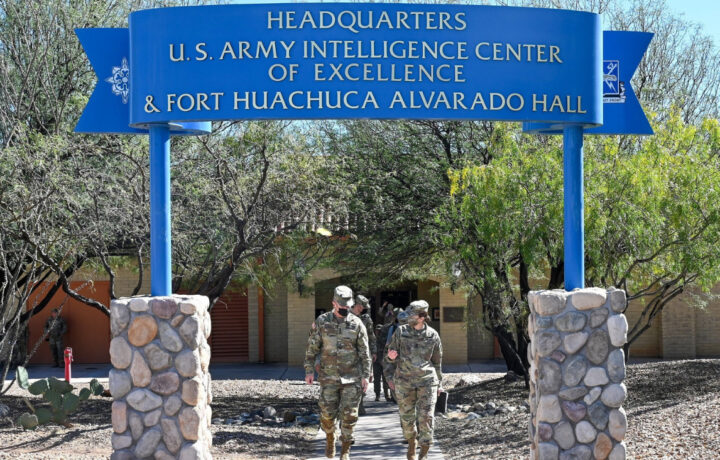The United States Army’s Fort Huachuca, AZ, has been the primary facility that trains soldiers in military intelligence. It has come quite a way from the days when the initial intelligence training facilities were just a World War II hospital complex that hadn’t been occupied for several years. The base is now home to the U.S. Army Intelligence Center of Excellence (USAICoE), where the 111th Military Intelligence Brigade oversees the responsibility for the four battalions who focus primarily on training Military Intelligence Corps soldiers.
This month, the 111 MI BDE announced the launch of the Threat Immersion Program, an initiative to remind students in the 304th MI Battalion (BN), 305th MI BN, 309th MI BN, and 344th MI BN, of the clear and present threats from America’s adversaries.
The Threat Immersion Program is broken into two parts, but there are plans for it to further evolve. It will provide insight and information on equipment and other military hardware currently employed by near-peer adversaries via a central database available to the larger MI community.
“We want to introduce real equipment too. RPGs, AK-47s… some of it will cost money that we don’t currently have,” said 111th MI BDE Commander Col. Patrick Schorpp.
Providing access to even larger hardware is already being explored, added Chief Warrant Officer 3 Scott Worley, who explained, “There is a possibility that we will see the adversary’s vehicles [on the Nicholson Hall back pad].
A Digital Training Program
While fiscal limitations could limit what the soldiers taking part in the program have access to in the physical world, virtual options are being provided. That includes training aids that reinforce what was taught in the classroom, so that much of it becomes second nature.
“We’re developing quizzes [on the student network],” said Worley. “When you log on to your computer, something will pop up and say, ‘what kind of vehicle is this?’ And it will be a T-72 or T-90 or 9A51. You will pick the correct answer, and then it will let you log in. If you select the wrong answer, it will give you the right answer and an explanation before moving to the login screen.”
The goal of the program is to develop more experienced intelligence warfighters, where recognizing potential threats becomes second nature. In this way, the classroom will teach theory, while outside of it, the students will be able to build their understanding of the real-world modern adversary.
Building On Eight Decades of Experience
Today’s 111th MIB can trace its origins to May 10, 1946 when it was constituted as the 111th Counter Intelligence Corps Detachment, and then activated weeks later in Atlanta, Georgia. Though the then 11th Military Intelligence Group was inactivated in January 1973, it was redesignated as the 111th Military Intelligence Brigade; concurrently transferred to the United States Army Training and Doctrine Command and activated at Fort Huachuca, Arizona, in March 1987.
It is now charged with conducting Initial Military Training, Professional Military Education. Its existing programs of instruction include the Military Intelligence Basic Officer Leader Course (MIBOLC), the Military Intelligence Captains Career Course (MICCC), Tactical Signal Intelligence (TACSIGINT), Open Source Intelligence (OSINT), and the Information Collection Planners Course (ICPC), among others. It also offers advanced individual training in a variety of specialist roles from intelligence analysis to counterintelligence and signals collection.
The new program could enhance the quality of MI Soldiers arriving at their units from Fort Huachuca.
“I’m hoping that this program lets them know that those threats are out there. I think we forget that sometimes as a country. Ukraine now knows that these threats are real. Taiwan is very close to finding out that those threats are real. Israel—the Iranian strikes that are happening back and forth—I mean, it’s real,” said Worley. “It’s happening. And understanding the baseline of what is out there and what your adversary has and how they fight are probably the best part of this program. The threat is real, and we need to know how to defend or fight it.”
That sentiment was echoed by Schorpp.
“Everywhere you go, you don’t forget that the threat is out there, and the adversary is real. It shouldn’t be this nebulous construct that’s out there somewhere,” Schorpp continued. “Everybody needs to understand what information the commander is after, and everyone has a role in extracting that.”


